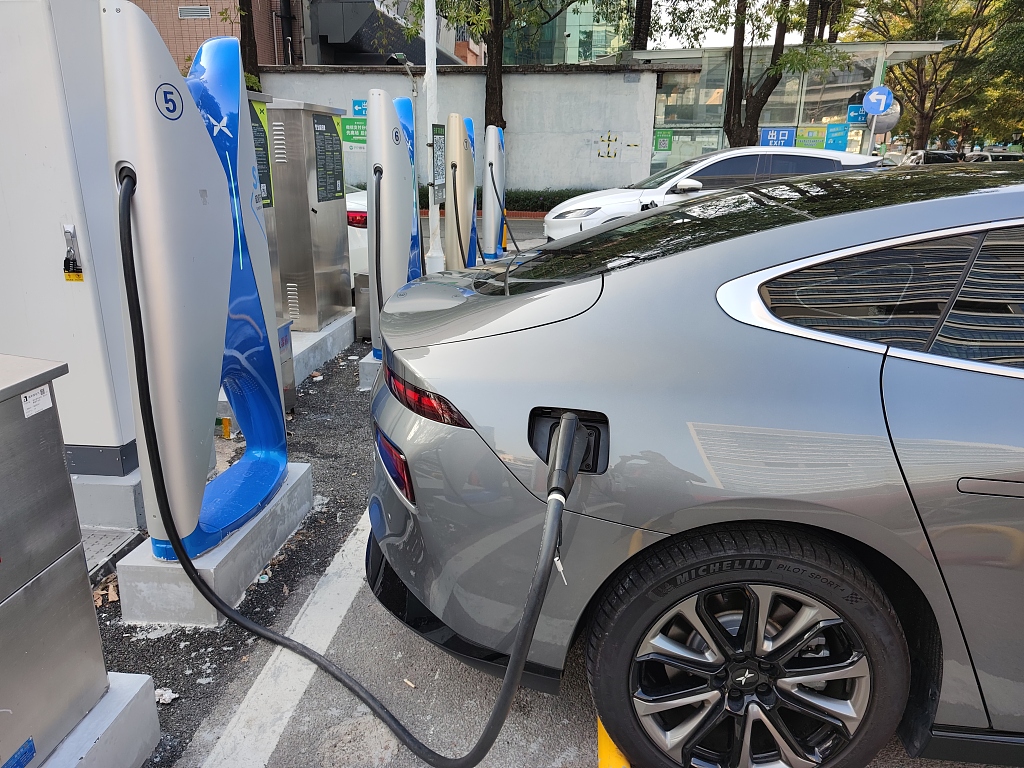
Charging piles for new energy vehicles are seen in Shenzhen, South China’s Guangdong province, on Oct 25, 2023. [Photo/VCG]
SHENZHEN – As the clock struck 4 pm, Zhong Yu concluded a meeting in Shenzhen’s Futian district and left for his office driving his sleek AVATR 11, a new energy vehicle (NEV) model.
En route, he made a pit stop at the Shenzhen Convention and Exhibition Center’s supercharging station to quickly recharge his car. Zhong shared that he often drives his NEV for work and on occasions when he overlooks charging it at home, the convenience of a supercharging station becomes a lifesaver.
The liquid-cooling supercharging station was built by China Southern Power Grid with technology support from Huawei. Its 600-kilowatt charger can charge Zhong’s AVATR 11, with 200 km mileage, in just 10 minutes.
This city in South China’s Guangdong province started building advanced NEV charging facilities in June 2023 to become “a city of supercharging,” and has set up 161 supercharging stations by the end of the year. The move is expected to relieve the range anxiety among NEV owners.
Supercharging is an advanced charging technology designed to surpass even the pace of fast charging. Boasting a remarkable maximum output power of 600 kilowatts and a maximum output current of 600 amps, this system can charge NEVs at a speed of up to 1 kilometer per second.
In October 2023, Shenzhen’s development and reform commission rolled out an action plan to build NEV supercharging stations from 2023 to 2025. Accordingly, the city will have built at least 300 such stations by the end of March 2024.
Shenzhen’s ambition was backed by its industrial chain. In terms of the charger manufacturing industry, Shenzhen is home to many enterprises specializing in charging module manufacturing and charger operation, such as Huawei, Winline and Infypower.
Chargers produced in Shenzhen account for more than 50 percent of the national market while charging modules manufactured in the city surpass 70 percent market share.
Besides the supercharging facilities, the NEV and power battery industries are also playing important roles in Shenzhen’s effort to become “a city of supercharging.”
As of the first half of 2023, the number of NEVs in Shenzhen reached 860,000, and the penetration rate of NEVs in the new car market exceeded 60 percent. Many new vehicle models launched in the market in recent years are equipped with supercharging technology.
BYD, headquartered in Shenzhen and one of China’s largest NEV manufacturers, has so far manufactured about 6 million NEVs.
It is estimated that by the end of 2025, the number of NEVs in the city will reach 1.3 million, and the NEV penetration rate in the new car market will hit 70 percent.
Shenzhen has some 24,000 new energy and digital energy enterprises as part of the supercharging industrial chain. Sunwoda Energy, headquartered in Baoan district, is one of China’s major power battery and consumer battery makers.
In April 2023, the company released a new type of supercharging power battery which can power the NEV to run 1,000 km, and can be recharged from 20 percent to 80 percent in just 10 minutes. The battery has already been supplied to NEV makers.
In June 2023, the State Council issued a guideline to further boost the building of a high-quality charging infrastructure network in order to meet the rapid development of the country’s NEVs.
Many provinces and cities have unveiled plans to beef up their supercharging infrastructure, including Hainan, Chongqing and Shandong, as well as Shenzhen’s neighboring city Guangzhou.
According to deputy secretary-general of China Electricity Council Liu Yongdong, the industrial chain is ready to produce core components of high-voltage NEVs. An increasing number of new car models equipped with supercharging technology will enter the market from the end of 2023.
The sector also has started commercializing the supercharging power battery and industrializing the charging facilities with output power as high as 1,000 kilowatts, Liu said.
